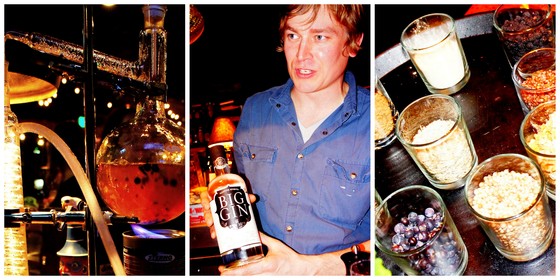Let's begin by reassuring the State Liquor Board and the federal revenuers that the "still" in the photo is for show-and-tell only, acquired from PelletLab.com so that Ben Capdevielle could demonstrate how distillation works. The botanicals in the boiling retort are real, though. It's a dog-and-pony show that Capdevielle took on the road this week for a class in gin-making. The real still, inside a grey clapboard house in Ballard, is a 100-gallon copper job from Vendome in Louisville, KY, a part of the country where distillation (licit and illicit) is an industry with a cultural history as important as, say, aerospace is out here.
The product of the legal effort (legal since the state gummint eased up on craft distilleries in 2008) is called Big Gin, produced by Capdevielle and his gang under a corporate umbrella named Captive Spirits. Big Gin is an aromatic spirit that falls into a category of gin generally referred to as "London Dry." That is, it's not overly sweet even with lots of juniper and orange peel in the nose. Compared to, say, Bombay Sapphire, it has nowhere near the perfume; it has none of the rose-water and cucumber aromatics of Hendricks. Captive spends more than other local craft distillers on its clothes: its gin is hand-bottled and sports an elegant label (by Chris Jordan of Shipwreck Design). All those botanicals, not cheap, either.
Captive will shortly release a second gin, aged in used bourbon barrels. The aging--a typical technique of a gin category known as "Old Tom"--mellows the flavors a bit and adds a hint of golden color. But the feds won't approve labels for gin that even suggest "aging," so the label will read, simply, Old Tom.
Capdevielle teamed up with the folks at Seatown (Tom Douglas's tourist-oriented snack bar at the Market) for the cocktail class. And using the show-and-tell still, with its juniper berries and botanicals bouncing happily in the retort, he explained that craft distillers use neutral, industrial-strength corn-based ethanol and infuse it with flavors. The orange esters, for example, dominate the first part of the distillation; how prominent should those flavors be? Each distiller's "recipe" (how much of this, how much of that) remains a closely guarded secret, even as their trade association, the Washington Distillers Guild, works with the Liquor Board to expand access to out-of-state markets.

Leave a comment